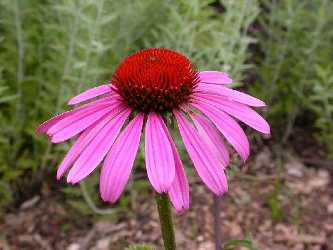Purple Coneflower ‘Magnus’ and ‘Rubinstern’
 Behnke Nurseries’ Perennial Department is featuring two cultivars of one of the best summer blooming perennials, the Purple Coneflower, Echinacea purpurea – ‘Magnus’ and Echinacea purpurea ‘Rubinstern’ (often translated as “Ruby Star.”) Although the common name is purple coneflower, they are really pink. Not my fault.
Behnke Nurseries’ Perennial Department is featuring two cultivars of one of the best summer blooming perennials, the Purple Coneflower, Echinacea purpurea – ‘Magnus’ and Echinacea purpurea ‘Rubinstern’ (often translated as “Ruby Star.”) Although the common name is purple coneflower, they are really pink. Not my fault.
These are similar seed-grown cultivars (being seed-grown they are somewhat variable in height and bloom color, but in general): Both top out at around 3 feet in height, but ‘Rubinstern’ is on average a bit shorter than ‘Magnus’ and has deeper pink flowers. They both have petals that are relatively horizontal as they open, like a daisy, rather than droopy like a shuttlecock, as is the case for many of the coneflowers. As the flowers age, they become more reflexed.
Heaviest bloom in June and July, continuing to bloom sporadically into August and even September. Blooming is heavier and longer with established plants, of course.
Siting is best in full sun, in good garden soil. Like many perennials, if you feed them regularly and water them frequently, the stems will be weak and the plants may fall over. Tough love and all that, once they are established.
They are native to the Eastern and Central United States, and are terrific in butterfly gardens. They also are a good addition to a hummingbird garden, as they attract small insects that hummers like to grab to supplement their nectar feeding. Seed-eating birds like goldfinches will be attracted to the ripening seed heads.
A summer garden or large container combination I like is planting Echinacea with Perovskia (Russian Sage), which has a blue flower and a similar bloom time. A silver-foliaged plant like an Artemisia or a Dusty Miller makes a particularly nice addition to the two.

This Post Has 0 Comments